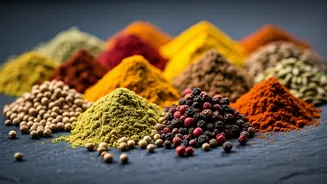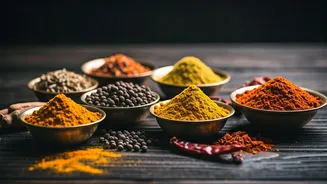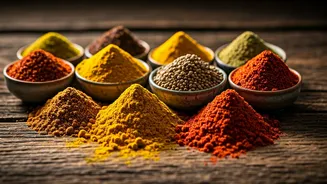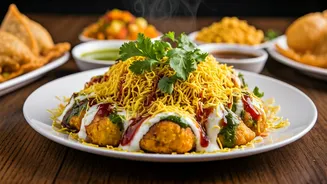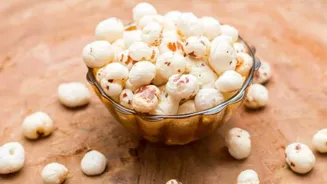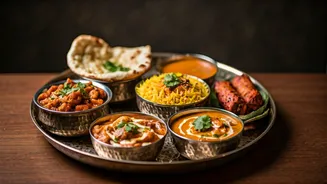Spice Route Begins
The journey into Indian cuisine begins with understanding the core ingredients. Spices play a pivotal role, with each region boasting its unique blend.
For instance, the South favors mustard seeds, curry leaves, and tamarind, lending a tangy and aromatic character to dishes like sambar and rasam. In contrast, the North often uses garam masala, a blend of roasted spices, to create rich, savory flavors in dishes like butter chicken and biryani. These spices are not just for taste; they also reflect the local climate, agricultural practices, and historical influences of each region. The use of fresh herbs like coriander, mint, and fenugreek further enhances the complexity of the flavors, providing a refreshing counterpoint to the intensity of the spices, thus offering a broad palette of tastes.
Northern Culinary Delights
Northern Indian cuisine is known for its creamy gravies, tandoori dishes, and the generous use of dairy products. The Mughlai influence is evident in the rich, slow-cooked curries like rogan josh and korma, which combine meat with a medley of aromatic spices. Tandoor cooking, a technique using a clay oven, is a hallmark of the region, producing dishes like tandoori chicken and naan. The use of ghee (clarified butter) adds a distinct richness, while nuts and dried fruits are often incorporated to elevate the textures and flavors. Bread, particularly naan, roti, and paratha, forms an essential part of the meals, serving as a perfect accompaniment to the savory curries and grilled meats. The culinary style is characterized by the use of wheat, with rice playing a secondary role compared to other regions.
Southern Flavors Abound
Southern Indian cuisine is characterized by its use of rice, lentils, and an array of fresh vegetables and seafood. The flavors are often vibrant, thanks to the liberal use of tamarind, coconut, and fresh chilies. Dishes such as dosa, idli, and vada are staples, typically served with sambar (a lentil-based vegetable stew) and various chutneys. Seafood, especially in coastal regions like Kerala and Tamil Nadu, is cooked with coconut milk, spices, and herbs, resulting in a unique combination of flavors. The use of coconut oil gives dishes a distinct aroma, and the frequent inclusion of curry leaves adds a refreshing touch. The emphasis on freshness and the use of locally sourced ingredients contribute to the region's diverse and nutritious offerings. Each state, from Kerala to Tamil Nadu, brings its individual spin to the table.
Eastward Food Explorations
Eastern Indian cuisine, encompassing states like West Bengal, Bihar, and Odisha, often uses a combination of subtle and complex flavors. Rice and fish are mainstays, and the cooking methods vary from slow simmering to frying. West Bengal is famous for its fish preparations, especially the iconic 'ilish' (hilsa) fish, cooked in various styles. Bihar offers dishes like litti chokha, made with roasted wheat balls and mashed vegetables, reflecting the region's simpler, earthy flavors. The influence of neighboring regions contributes to the diversity, with dishes often incorporating influences from the Mughal and British eras. Mustard oil is frequently used, providing a pungent, distinctive taste. The region's emphasis on simplicity and fresh, local ingredients showcases the authenticity of Eastern Indian culinary practices.
West's Gastronomic Gems
Western Indian cuisine, particularly from Maharashtra and Gujarat, offers a range of flavors, with both vegetarian and non-vegetarian options. Maharashtra is celebrated for its spicy curries, such as 'vada pav' and 'pav bhaji,' street food favorites that blend bold spices with the comfort of soft bread. Gujarat features a predominantly vegetarian diet, emphasizing sweet, sour, and spicy tastes. Dishes like 'dhokla' and 'thepla' are common, often served with chutneys and pickles. Seafood also plays a significant role along the coast. The use of regional spices and ingredients like kokum and jaggery distinguishes the culinary style. The blend of influences, including those from its maritime history and neighboring states, gives Western Indian cuisine its unique identity.
Sweet Endings: Desserts
Desserts in India are as diverse as the cuisines themselves, often incorporating local ingredients and traditional cooking methods. Gulab jamun, rasgulla, and jalebi are some of the most popular sweets found across the country, each with unique textures and flavors. Regions also have unique specialities, such as payasam (a type of rice pudding) from the South, and barfi variations across the North. Many desserts feature milk products, like khoya (reduced milk solids), adding richness and creaminess. The use of nuts, dried fruits, and spices like cardamom and saffron further enhances the sweetness and complexity of the desserts. The desserts provide a delightful culmination to any Indian meal, often consumed during festivals and celebrations, thereby weaving sweetness into the fabric of Indian culture.
